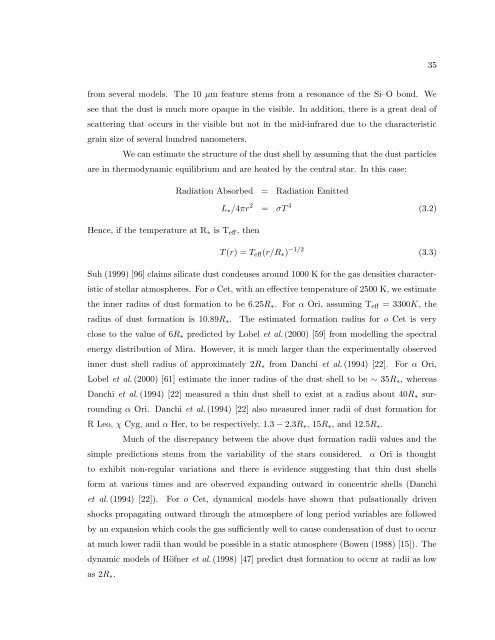The Size, Structure, and Variability of Late-Type Stars Measured ...
The Size, Structure, and Variability of Late-Type Stars Measured ...
The Size, Structure, and Variability of Late-Type Stars Measured ...
You also want an ePaper? Increase the reach of your titles
YUMPU automatically turns print PDFs into web optimized ePapers that Google loves.
35<br />
from several models. <strong>The</strong> 10 µm feature stems from a resonance <strong>of</strong> the Si–O bond. We<br />
see that the dust is much more opaque in the visible. In addition, there is a great deal <strong>of</strong><br />
scattering that occurs in the visible but not in the mid-infrared due to the characteristic<br />
grain size <strong>of</strong> several hundred nanometers.<br />
We can estimate the structure <strong>of</strong> the dust shell by assuming that the dust particles<br />
are in thermodynamic equilibrium <strong>and</strong> are heated by the central star. In this case:<br />
Radiation Absorbed = Radiation Emitted<br />
L ∗ /4πr 2 = σT 4 (3.2)<br />
Hence, if the temperature at R ∗ is T eff , then<br />
T (r) = T eff (r/R ∗ ) −1/2 (3.3)<br />
Suh (1999) [96] claims silicate dust condenses around 1000 K for the gas densities characteristic<br />
<strong>of</strong> stellar atmospheres. For o Cet, with an effective temperature <strong>of</strong> 2500 K, we estimate<br />
the inner radius <strong>of</strong> dust formation to be 6.25R ∗ . For α Ori, assuming T eff = 3300K, the<br />
radius <strong>of</strong> dust formation is 10.89R ∗ . <strong>The</strong> estimated formation radius for o Cet is very<br />
close to the value <strong>of</strong> 6R ∗ predicted by Lobel et al. (2000) [59] from modelling the spectral<br />
energy distribution <strong>of</strong> Mira. However, it is much larger than the experimentally observed<br />
inner dust shell radius <strong>of</strong> approximately 2R ∗ from Danchi et al. (1994) [22]. For α Ori,<br />
Lobel et al. (2000) [61] estimate the inner radius <strong>of</strong> the dust shell to be ∼ 35R ∗ , whereas<br />
Danchi et al. (1994) [22] measured a thin dust shell to exist at a radius about 40R ∗ surrounding<br />
α Ori. Danchi et al. (1994) [22] also measured inner radii <strong>of</strong> dust formation for<br />
R Leo, χ Cyg, <strong>and</strong> α Her, to be respectively, 1.3 − 2.3R ∗ , 15R ∗ , <strong>and</strong> 12.5R ∗ .<br />
Much <strong>of</strong> the discrepancy between the above dust formation radii values <strong>and</strong> the<br />
simple predictions stems from the variability <strong>of</strong> the stars considered. α Ori is thought<br />
to exhibit non-regular variations <strong>and</strong> there is evidence suggesting that thin dust shells<br />
form at various times <strong>and</strong> are observed exp<strong>and</strong>ing outward in concentric shells (Danchi<br />
et al. (1994) [22]). For o Cet, dynamical models have shown that pulsationally driven<br />
shocks propagating outward through the atmosphere <strong>of</strong> long period variables are followed<br />
by an expansion which cools the gas sufficiently well to cause condensation <strong>of</strong> dust to occur<br />
at much lower radii than would be possible in a static atmosphere (Bowen (1988) [15]). <strong>The</strong><br />
dynamic models <strong>of</strong> Höfner et al. (1998) [47] predict dust formation to occur at radii as low<br />
as 2R ∗ .













![Problem #1 [Structure Formation I: Radiation Era]](https://img.yumpu.com/37147371/1/190x245/problem-1-structure-formation-i-radiation-era.jpg?quality=85)


